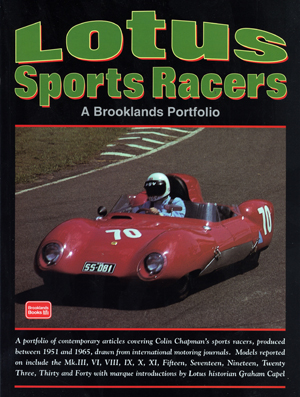Úvod »Automobily osobní a dodávky»Studebaker » Lotus Sports Racers
Anotace
The Front Engined Lotus Sports Racing 1951-1959 - Between 1951 and 1959 Lotus produced eight front engined sports racing cars each of which contained innovative engineering design developments. From humble beginnings using converted Austin Seven based specials, Colin Chapman developed his own chassis and produced his own sports car. Over the following eight years with a new Lotus model each year, with each model distinctively different from its predecessor, Lotus rose from the ranks of a special builder to a race winning constructor of sports racing cars which included countless race victories at circuits throughout the world, plus success at world renowned international races at Le Mans and Sebring. The Lotus Mark III of 1951 set the trend for Lotus lightweight sports racing cars, although the Austin Seven chassis formed the basis of the car with much Lotus modification, and an even more modified Austin engine. The Lotus Mark VI of 1952 saw the beginning of the Chapman designed space frame chassis, and torsional strength with riveted body panels. The use of modified standard production components saw the Lotus developed independent suspension by divided Ford front axle which lasted throughout the first five models until 1957. Over three years of production Lotus sold some 110 Mark VI cars. The Lotus Mark VIII of 1954 was a radical aerodynamic design for international sports car racing, and featured a fully triangulated space frame chassis on the prototype which proved effective, but impractical. Only six Mark VIIIs were built. The remaining cars used modified Mark VI chassis and Lotus gained some impressive race victories to establish their reputation in British motor racing. The Lotus Mark IX of 1955 saw the move to Lotus designed standardisation of specialised parts, plus modified aerodynamics on the body shape. About 25 Mark IX cars were sold, with a substantial number to the USA where Lotuss reputation was developing. The Lotus Mark X, also of 1955, was a customer inspired move into larger capacity sports racing cars which caused Lotus some problems and included detachable chassis tubes, disc brakes, etc. Only 6 cars were produced. The Lotus Eleven of 1956 was the major step forward which established Lotus as a winning sports racing constructor. It also set the trend for Lotus models beginning with the letter E. The Lotus Eleven was an exercise in style and shape. Component accessibility was superb and the car was offered in a choice of three options, and with a variety of body styles. The big innovation was the use of rack and pinion steering and later, with the Series 2 of 1957, wishbone front suspension that was to be the mainstay of Lotus design for the next three years and was used on five models. A total of 270 were built in three years of production, and were sold all over the world. The Lotus Fifteen of 1959 was a larger capacity sports racing car aimed at international competition. When it worked, it worked very well and achieved some major international success for Lotus. However, it was hampered by the rear mounted Lotus ‘queerbox’ sequential gearbox on the earlier models. Twenty eight were produced and were driven at major international races to build on Lotuss reputation. The Lotus Seventeen of 1959, was not a success. Chapman was too busy on a multitude of developments, and the innovative strut front suspension did not work adequately. A total of 20 cars were built. The Rear Engined Lotus Sports Racing Cars 1960-1965 - Lotus were slow to move into the rear engined innovation of the late 1950’s, but when they did with their rear engined Lotus 18 in 1959, the supremacy was soon established. Stirling Moss in Rob Walker’s Lotus 18 F1 scored the first Grand Prix victory in a Lotus at Monaco in May 1960, and Innes Ireland won at Watkins Glen late in 1961 to score the first Grand Prix victory for Team Lotus. ?In the meantime Lotus sports racers also became rear engined. The Lotus Nineteen of 1960 was designed to continue Lotus prestige in large capacity sports car racing, and although only 12 cars were built, they were very fast. Most success was achieved in USA. The Lotus Twenty Three of 1962 was a return to small capacity sports racing cars on which Lotus had built their reputation in the mid-1950s. This was as successful as its predecessors, and won races all over the world. It is still winning in historic racing today. Some 131 cars were built with engines from 1100cc-1800cc. The Lotus 30 was a great idea, and a superb looking car when it was introduced in 1964, but it failed to deliver the goods. The problem was the lack of torsional stiffness in the uprated Elan type backbone chassis which just could not cope with the V8 power. A total of 33 cars were built. The Lotus 40 of 1965 was the last sports racing car to be built by Lotus. It was a dismal failure and only 3 were built. It was a sad finale for Lotus to relinquish their construction of sports racing cars in which they had made such a name for themselves over the past 15 years. 344 pages, 750 illus.



















